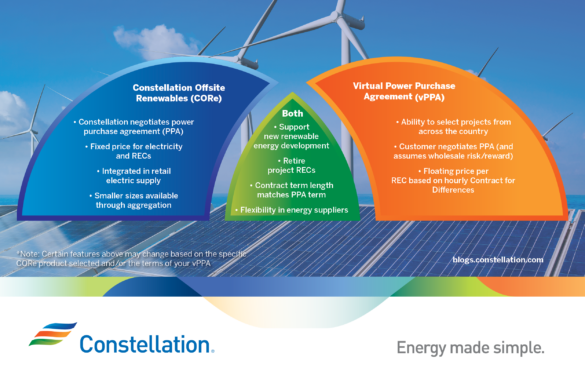Selecting a Renewables Project: Evaluate Risk vs. Reward
The industry continues to see growth in renewable mandates as well as significant increases in voluntary renewable purchases. Many of the country’s largest companies and organizations are driving this growth through their commitments to renewable energy. One of the many ways they buy renewable energy is with long-term power purchase agreements (PPAs).
As power sources become greener, organizations are seeking guidance in navigating the options and risks associated with purchasing renewable power supply. Companies can look to industry experts for assistance with identifying key factors that may affect a project and simplify what is becoming a crowded marketplace.
The path to help companies identify the renewable project best aligned to their goals includes:
1. Access to marketplace data
Finding the right renewables project is all about having access to data—and that starts with knowing what projects are available by looking at the size, developer, location, technology, load shape, price, etc. that aligns with your needs. Analytics lead to informed decisions by combining all factors, including future energy prices and weather. Navigating the strategic input and analytics can help companies choose the renewable project that best meets their needs and provides long-term value. Constellation has applied its established industry experience with PPAs to the renewables space, utilizing that expertise to identify the best projects for customers based on viability, cost, grid location and other factors.
2. Evaluation and risk framework
Analytics play a pivotal role in determining the best project for a company by using data to provide projected outcomes of PPAs, including likely risk scenarios. Companies should ensure that their renewable project can exist in the current and future marketplace, and that the project is correctly valued against its risk. To get to these outcomes, complex simulations are run to predict a range of probable outcomes for key factors, such as probable contract value and yearly cashflow. Each of these outcomes provides thoughtful insights for energy and sustainability managers to define their risk preferences and find a PPA aligned with their goals.
3. Decision making
Traditionally, energy buyers may have only considered the net present value (NPV) of a potential renewable project to make a decision. NPV is one metric to measure a project, but it’s not the only factor when making a renewable PPA investment. Price doesn’t always equal value, especially when looking at a 10-15-year forecast of energy prices that change every hour of every day. After a comprehensive analysis of the marketplace and underlying business requirements, companies should consider selecting the project with the highest expected return for a given amount of risk in the transaction.
Many companies don’t have the capacity to fully assess strategies to buy energy for a 10-15-year timeframe, so industry support and project valuation are crucial for selecting the best option. Constellation leverages its decades of experience with renewable PPAs, coupled with the innovative analytics capabilities of strategic relationships, to provide commercial opportunities to companies that are considering renewable energy purchases, including location-specific and/or new-build options through our Constellation Offsite Renewables (CORe(+)) offerings. Our risk framework and perspective look at both fundamental and market curves to provide a better picture of risk versus reward for a renewable project.
As more businesses commit to meeting renewable energy goals, customers can look to companies like Constellation to gather and analyze data as well as implement impactful renewable energy options. To learn more about the right renewables project for your business and impactful product options, contact us today www.constellation.com/SET.
Structured retail products, like Constellation’s CORe+ solution, differ from virtual power purchase agreements (PPA). Learn more in the image below.


